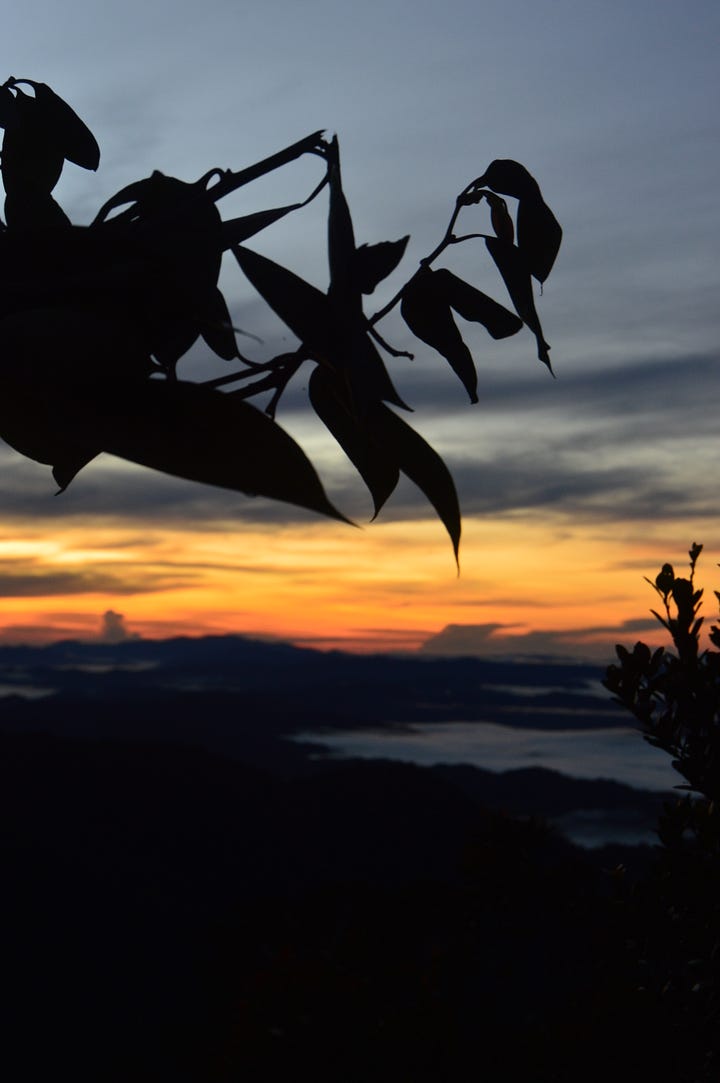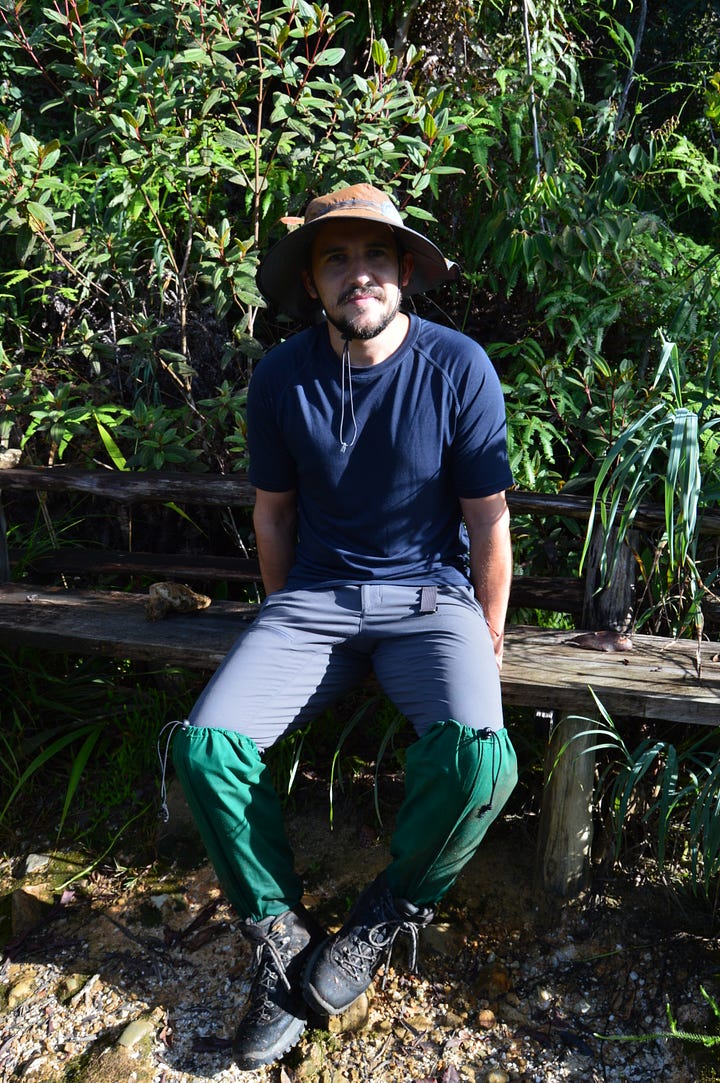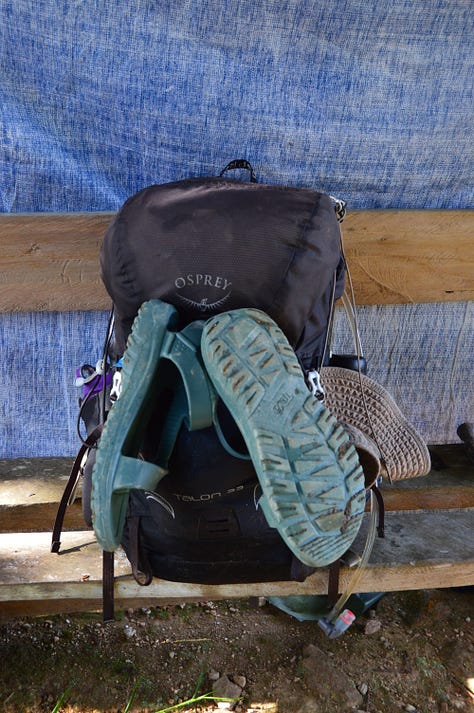Time is a perplexing phenomenon, slipping through our fingers when we’re not looking, slowing down to a snail’s pace when observed. I am no physicist, but I would wager that time flows differently in the jungle too. It expands, slows down, plays tricks on you. There may be obvious reasons for this – the lack of distractions, the total immersion in your environment, the hyper-awareness, the observation of everything. Perhaps it’s just animal instinct, a finetuning of the senses that have been so dulled by modern life – but reacquainting yourself with time in this way is a strange thing.
Last week, we spent a lot of time in the jungle. Somehow, my dad convinced us to join him for a three-day hiking expedition ascending Mt Trusmadi in Borneo. Standing at 2,642 metres, it’s the second highest peak on the island, after Mt Kinabalu – but I’d been promised it was the hardest, as if that would reassure me somehow. I’d also been promised leeches, just to sweeten the deal.
On Nathaniel’s birthday, we flew into Kota Kinabalu, the capital of the state of Sabah on the Malaysian side of Borneo. That evening, we ate a barbecued turmeric fish with nasi goreng in one of the seafront restaurants – the sort with plastic chairs, a red plastic tablecloth and a fan whirring overhead, where each dish costs around 10 ringgit. We left full and we slept well, with little idea of just how arduous the next day would be.
In short, there was a lot of walking, vertiginously uphill through thick rainforest, rivers and bogs. You can’t hike the mountains of Borneo without a guide, and you also need a permit to access them. With good reason, it turns out – it would have been impossible to navigate Trusmadi without someone who had an intimate understanding of the terrain. Our guide, Shed (pronounced Sed), is a member of the local Dusun tribe, a couple of years older than me, at a guess. He told us he had been up Trusmadi 242 times, joking that he would retire when he hit 250. He knew the terrain like the lines on his palm, every dip and peak, every fallen tree. When the path seemed unnavigable, he would pull a machete from his backpack and simply create a new one.
Each day, we ascended 1,000 metres in relentless rain – who knew it rained so much in the rainforest? Ambling, leech-infested tracks gave way to slippery ascents with ropes and ladders. Then there were the long, slow passages through deep jungle. Wrapped in mist, it would feel as if we were walking around in circles – just a canopy of dripping greens and twisted mud tracks in every direction, the scene changing very little with each step. Minutes dragged into hours, uneventfully, until we’d look up and find ourselves in a completely different terrain. High near the summit, the canopy opened to the sky, and we felt the shock of daylight like something alien. Winding corridors of endemic flora and fauna, pathways framed with carnivorous flowers in striking shades of red and yellow – a naturalist’s dream.




But what a journey it was to get there. How long it all felt. I frequently wondered what the point of it was – there were many moments in which it felt both intensely difficult and boring. I began to question everything I knew about time and distance, not understanding how a mere 100 metres could feel like a mile, or how an hour could feel like half a day. We felt the weight of the journey in our bodies, the ache of our muscles and feet, with no option but to keep going.
I’ve felt the strange warp of time once before, during a three-day pottery wood-firing using the ancient anagama (“cave kiln”) method. I wrote about the experience in An account of fire. What struck me then, as it does now, is the element of complete psychological immersion – the feeling that nothing exists outside the parameters of your immediate world. It’s like the hallucinogenic experience, part and parcel with the sensation of time slowing right down.
Such events unfold in a liminal space. You leave some kind of normality behind, moving into a new and unknown place. There’s often a real element of danger, whether it’s a 1300-degree fire or precipitous mountain edges. For that reason, you often need a guide – someone who will help you navigate your way safely to the other side.
The element of duration is what imbues the experience with meaning. For the entire three days, I had my phone switched off, and at first, I felt unmoored. As if I had cut the tether that connected me to the wider world. There was no signal in the mountains anyway, but the feeling of not knowing what the time was, the exact time, added to a certain feeling of isolation. For the most part, we couldn’t even see the sun, so the duration of our days was measured by feeling, by listening to the rhythms of the body. There were moments when everything felt impossibly slow, as if nothing was changing. But that’s what it feels like to move through the physical and natural world in real time – not digital time, not machine time.
I was thinking about these contrasts when I came across the ideas of the French philosopher and cultural theorist Paul Virilio, via this excellent Substack essay by Kirk Gordon. According to Virilio’s theory of dromology, living in a technologically advanced capitalist society has compressed our experience of distance and duration, resulting in a loss of a spatial-temporal consciousness. Machine-enhanced convenience means we expect things to happen instantaneously. We expect to be able to hurl a message in a bottle to the other side of the world in mere seconds, bypassing the oceans altogether. We want things here and we want things now.
We don’t really know what time, in its fluid, shapeshifting richness, feels like anymore. Universal time blinks at us in hard numbers from our devices, stuck on an immediate, instantaneous loop. Instantaneity is the lifeblood of capitalism, and speed is a particular Western obsession – more productivity, more profit, in less time. Things running like clockwork, a system in self-perpetuating motion. It is the fantasy of man as machine, the pursuit of streamlined perfection, doing away with things as inconvenient, as feminine, as distance and time. A world severed from the rhythms and cycles of the natural world.
Walking is an incredibly slow way to travel, but it reminds us of the vastness of the world at a time when it feels like it’s only getting smaller. The great and improbable beauty of it. It helps us perceive the delicate relationships that exist between everything, and what it means to move through a physical space like the animals we are. The mountain becomes significant in the climbing, the slow and steady journey.



The joy of jungle food
Enough philosophy and onto the good stuff. All great journeys are enhanced by food, and it was an absolute luxury to have a dedicated cook with us, as well as a guide. Rosiana was a formidable hiker, ploughing miles ahead with a backpack almost the same size as she was, filled with three days’ worth of ingredients and cooking utensils. She described the food, almost apologetically, as “jungle food” – simple Malaysian comfort dishes, but my goodness, they were delicious.
I briefly wrote about my own version of a tomato egg-drop soup here, but got to taste the proper thing on our first night at the camp. I always enjoy making soup but don’t tend to crave it that often, and I forget just how comforting and revitalising it can be. Rosiana’s soup was a gift. The warm, salty broth, the delicate strands of egg and juicy tomatoes – it felt, in that moment, as if I had never tasted anything so good. We slurped it out of little bowls, topping it up again and again, until we were slowly restored.
Eating is a joy, but in extreme conditions, it is also a necessity. Food is fuel. It doesn’t need to be particularly good to keep us going, but it’s a real treat when it’s actually delicious. Perhaps what I love most about the idea of jungle food, in Rosiana’s iteration, is the focus on simplicity and flavour. No frills and minimal faff – the sort of stuff that can be cooked in one trusty old pan.
Here are some of the things we gratefully ate while resting our aching feet:
Mee goreng, or breakfast noodles. I could write a whole article on how much I love eating noodles for breakfast (I am a total noodle fiend, at all times of day). Thick, chewy wheat-egg noodles, fried with lots of dark soy sauce.
Nasi goreng, also for breakfast, which is the Malay and Indonesian name for fried rice. Served with a perfectly runny fried egg on top.
Bok choy, gently wilted, cooked with sliced garlic in soy sauce and sesame oil.
Lots of omelette, fried with onions over a high heat, with deliciously crispy edges. Sometimes finely sliced and added to stir-fried vegetable dishes.
Chicken was the meat of choice, cooked with soft, fleshy aubergines in a mild curry sauce; or with green beans in a thick soy gravy.
Fried, golden-skinned tofu with julienned carrots and green beans in a lighter soy gravy.
Morning glory – wilted river greens cooked with garlic and a little chilli. A true Southeast Asian comfort dish, a family favourite when I was growing up. The perfect accompaniment to anything.





From first root to final leaf...